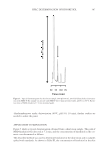VIRGIN OLIVE OIL–BASED COSMETIC CREAMS 373 This study was aimed at assessing the infl uence of the concentration and the sensory pro- fi le of different virgin olive oils on the odor of cosmetic creams produced by two different methods. MATERIALS AND METHODS OLIVE OIL SENSORY PROFILES Four locally available virgin olive oils of different quality were used for cream prepara- tion: extra virgin, Coratina variety, harvest 2011 (A) extra virgin, Picual variety, harvest 2011 (B) virgin, Arbequina and Picual bivarietal, harvest 2010 (C) and ordinary virgin (D). The commercial quality of the above oils was confi rmed and a descriptive profi le obtained from the analysis of a nine-assessor panel recruited and trained as per COI standards (24). The oils were evaluated in duplicate over two consecutive work sessions. To minimize the possibility of systematic error, samples were presented on a random basis. Fifteen milliliter of oil was poured into blue-colored tasting glasses (25) to exclude the visual factor. Oil samples codifi ed with three-digit random numbers were presented at 28 ± 2°C and rated on 10-cm unstructured scales according to each of the following positive and negative attributes: fruity (greenly/ripely), bitter, pungent, green (leaves/herbs), fi g tree, tomato (plant, leaves, fruit), apple, banana, almond/nuts, sweet, and astringent, among other positive attributes and fusty/muddy sediment, musty/humid/earthy, winey/ vinegary/acid/sour, frostbitten olives (wet wood), and rancid, among other negative at- tributes. Evaluations were conducted in a tasting room equipped as per COI/T.20/Doc. No. 6/Rev. 1, with fi ve individual cabins furnished with temperature control (22–24°C) and air circulation means. CREAM PREPARATION PROCEDURE To establish the possible effect of heating on the odor of creams, both hot and cold prep- aration methods were used. Two bases were used for cream preparation: base C (cold method) and base H (hot method). Four virgin olive oils (A, B, C, and D) at concentra- tions of 3%, 5%, and 10% were used in the preparation of each such base to provide ad- equate emollient action (26,27). Control creams were prepared with mineral oil (E). A total of 30 creams were prepared (Table I). Base C: O/W emulsion prepared by the cold method a preneutralized, lightly cross-linked, highly branched polymer, also acting as a consistency agent, was used as emulsifi er. Ingredi- ents according to International Nomenclature of Cosmetic Ingredients (INCI): aqua, acry- lates/acrylamine copolymer (and) mineral oil (and) polysorbate 85, propylene glycol (and), methyl paraben (and) propyl paraben, butylated hydroxytoluene. Emulsifi er, oil, propylene glycol (and), methyl paraben (and) propyl paraben and butylated hydroxytoluene dissolved in water were mixed at room temperature on a mechanical shaker (Servodyne Mixer Heat 50003-45, Cole Parmer Instrument Co. Vernon Hills, IL) at 500 rpm for 5 min. Base H: O/W emulsion with nonionic emulsifi er. INCI ingredients: aqua, ceteareth-20, cetostearyl alcohol, glyceryl monostearate, propylene glycol (and) methyl paraben (and)
JOURNAL OF COSMETIC SCIENCE 374 propyl paraben, butylated hydroxytoluene. One half of the total water amount, ceteareth-20, cetostearyl alcohol, glyceryl monostearate, propylene glycol, methyl paraben, propyl paraben, and butylated hydroxytoluene were water bath heated at 75–80°C for 10 min. Five-minute mechanical agitation (Servodyne Mixer Heat 50003-45) at 500 rpm was applied to disperse phases. The remaining amount of water was then slowly added at room temperature (25°C), using mechanical agitation. For both base C and base H, 300 g cream were prepared from each of the studied oils at the three concentrations studied. Table I shows the coding scheme used to identify each of the studied cream compositions. SENSORY EVALUATION OF CREAMS The sensory panel previously used to evaluate the starting olive oils evaluated those 10 creams containing 10% of oil (Table I). Initially, the odor evaluation method was stan- dardized. The assessors were then asked to describe and report major differences in the odor of samples, enabling the selection of appropriate descriptors: fruity and defective. The 30 creams were evaluated over six separate sessions, i.e., fi ve creams per session, pre- sented in random manner in opaque plastic containers with lids, containing 20 g cream coded with three-digit random numbers. The cream samples were warmed in the asses- sors’ hands, uncovered, and deep-olfacted, followed by shorter olfactions. Cream odor was rated according to fruitiness and defectiveness on 10-cm unstructured scales ranging from none at all to too much. The assessors were also asked to describe the defective odor whenever detected. Table I Cream Composition and Coding Scheme Oil type Oil content (%) Cream code Cold method Hot method A 3 AC3 AH3 5 AC5 AH5 10 AC10 AH10 B 3 BC3 BH3 5 BC5 BH5 10 BC10 BH10 C 3 CC3 CH3 5 CC5 CH5 10 CC10 CH10 D 3 DC3 DH3 5 DC5 DH5 10 DC10 DH10 E 3 EC3 EH3 5 EC5 EH5 10 EC10 EH10
Purchased for the exclusive use of nofirst nolast (unknown) From: SCC Media Library & Resource Center (library.scconline.org)





















































































